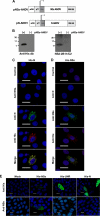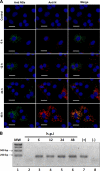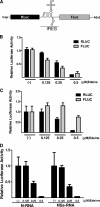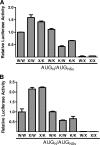The Andes hantavirus NSs protein is expressed from the viral small mRNA by a leaky scanning mechanism
- PMID: 22156529
- PMCID: PMC3302399
- DOI: 10.1128/JVI.06223-11
The Andes hantavirus NSs protein is expressed from the viral small mRNA by a leaky scanning mechanism
Abstract
The small mRNA (SmRNA) of all Bunyaviridae encodes the nucleocapsid (N) protein. In 4 out of 5 genera in the Bunyaviridae, the smRNA encodes an additional nonstructural protein denominated NSs. In this study, we show that Andes hantavirus (ANDV) SmRNA encodes an NSs protein. Data show that the NSs protein is expressed in the context of an ANDV infection. Additionally, our results suggest that translation initiation from the NSs initiation codon is mediated by ribosomal subunits that have bypassed the upstream N protein initiation codon through a leaky scanning mechanism.
Figures





Similar articles
-
The Andes Orthohantavirus NSs Protein Antagonizes the Type I Interferon Response by Inhibiting MAVS Signaling.J Virol. 2020 Jun 16;94(13):e00454-20. doi: 10.1128/JVI.00454-20. Print 2020 Jun 16. J Virol. 2020. PMID: 32321811 Free PMC article.
-
Tula hantavirus NSs protein accumulates in the perinuclear area in infected and transfected cells.Arch Virol. 2010;155(1):117-21. doi: 10.1007/s00705-009-0546-y. Epub 2009 Dec 3. Arch Virol. 2010. PMID: 19956987
-
The viral nucleocapsid protein and the human RNA-binding protein Mex3A promote translation of the Andes orthohantavirus small mRNA.PLoS Pathog. 2021 Sep 21;17(9):e1009931. doi: 10.1371/journal.ppat.1009931. eCollection 2021 Sep. PLoS Pathog. 2021. PMID: 34547046 Free PMC article.
-
The 3' untranslated region of the Andes hantavirus small mRNA functionally replaces the poly(A) tail and stimulates cap-dependent translation initiation from the viral mRNA.J Virol. 2010 Oct;84(19):10420-4. doi: 10.1128/JVI.01270-10. Epub 2010 Jul 21. J Virol. 2010. PMID: 20660206 Free PMC article.
-
Hantavirus structure--molecular interactions behind the scene.J Gen Virol. 2012 Aug;93(Pt 8):1631-1644. doi: 10.1099/vir.0.042218-0. Epub 2012 May 23. J Gen Virol. 2012. PMID: 22622328 Review.
Cited by
-
Post-translational modifications of hnRNP A1 differentially modulate retroviral IRES-mediated translation initiation.Nucleic Acids Res. 2020 Oct 9;48(18):10479-10499. doi: 10.1093/nar/gkaa765. Nucleic Acids Res. 2020. PMID: 32960212 Free PMC article.
-
Mother-to-Child Transmission of Andes Virus through Breast Milk, Chile1.Emerg Infect Dis. 2020 Aug;26(8):1885-1888. doi: 10.3201/eid2608.200204. Emerg Infect Dis. 2020. PMID: 32687024 Free PMC article.
-
The Andes Orthohantavirus NSs Protein Antagonizes the Type I Interferon Response by Inhibiting MAVS Signaling.J Virol. 2020 Jun 16;94(13):e00454-20. doi: 10.1128/JVI.00454-20. Print 2020 Jun 16. J Virol. 2020. PMID: 32321811 Free PMC article.
-
Inhibition of interferon I induction by non-structural protein NSs of Puumala virus and other vole-associated orthohantaviruses: phenotypic plasticity of the protein and potential functional domains.Arch Virol. 2021 Nov;166(11):2999-3012. doi: 10.1007/s00705-021-05159-y. Epub 2021 Aug 13. Arch Virol. 2021. PMID: 34389893 Free PMC article.
-
Experimental infection of Rio Mamore hantavirus in Sigmodontinae rodents.Mem Inst Oswaldo Cruz. 2016 May 24;111(6):399-402. doi: 10.1590/0074-02760160021. Mem Inst Oswaldo Cruz. 2016. PMID: 27223653 Free PMC article.
References
Publication types
MeSH terms
Substances
Grants and funding
LinkOut - more resources
Full Text Sources
Other Literature Sources
Medical

